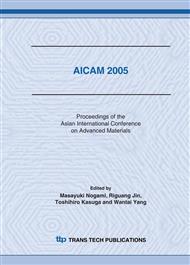p.391
p.395
p.399
p.403
p.407
p.413
p.417
p.421
p.425
Preparation and Electrochemical Performance of Cathode Material Carbyne Polysulfide for Lithium Batteries
Abstract:
Lithium rechargeable battery is a new type of battery developed in recent years. The studies on this system are naturally focused on the cathode material. The cathode material with conducting skeleton and energy-storing side lines was reported and a novel material carbyne polysulfide was studied. This paper was to explore a convenient approach for preparing carbyne polysulfide. The products obtained by co-heating polyvinylidene chloride(PVDC) and pulverized sulfur in ammonia environment was characterized by DSC /TG, IR, Raman spectrums and elemental analysis. And the product had been proved to have a sp2 hybride carbon skeleton with polysulfide attached on it, which resembles the theoretical structure of carbyne polysulfide. The material with favorable sulfur contents exhibited high specific capacity up to 705 mAh/g in the initial cycle and a stable reversible capacity approximately 420 mAh/g.
Info:
Periodical:
Pages:
407-412
Citation:
Online since:
February 2006
Authors:
Keywords:
Price:
Сopyright:
© 2006 Trans Tech Publications Ltd. All Rights Reserved
Share:
Citation:


